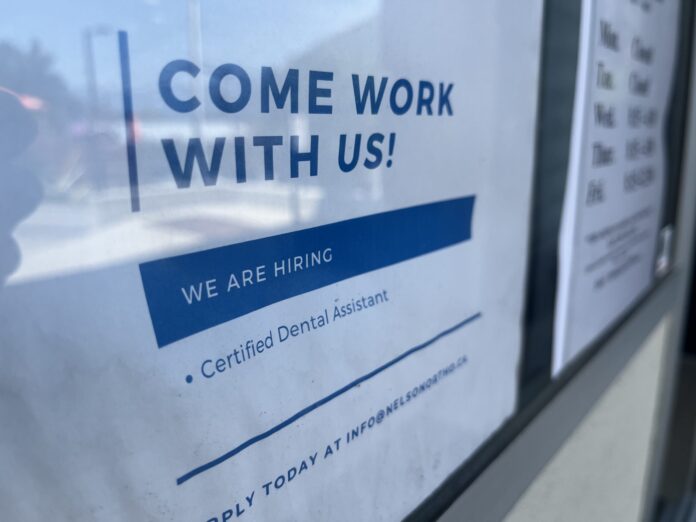A province-wide dental worker shortage is hitting rural communities the hardest, according to the BC Dental Association.
Dr. Salima Dadani, Director of Member Support with the BC Dental Association, said the shortage includes dentists and certified dental assistants (CDAs) and is calling on the federal and provincial governments to aid in recruitment and retention.
According to Dadani, data from the British Columbia College of Oral Health Professionals has shown negative growth in CDA recruitment over three years, with 2020-21 registration data revealing a 0.73 per cent decrease and another 0.2 per cent in 2022-23.
While the decrease may not seem significant, Dadani said it’s alarming because the industry has been facing a shortage for many years already.
“We already have a shortage; we already need more CDAs, and what we’re seeing is that we’re losing them. So we’re not even meeting what we need.”
She said for every dentist in the province, there needs to be a ratio of 1.75 CDAs per dentist.
Impacts from the Canadian Dental Care Plan
In December 2023, the federal government launched its Canadian Dental Care Plan, which aims to provide dental coverage for uninsured Canadians with an adjusted family net income of less than $90,000.
The plan was made available to eligible seniors first, but on June 27, it was expanded to include children under 18 and persons with a valid tax credit certificate, according to the Canadian Government’s website.
The goal is to expand the plan by 2025 to all age groups, but Dadani fears the provincial shortage of dental professionals will be a barrier for people trying to use it.
“It would be a shame if the government is paying for them to access dental care, but they have no dentists to go to, no dental office to go to, reduced hours, or dental offices that are already at full capacity and can’t take any more patients.”
Dadani said the plan is fantastic in how it will allow more people to access dentistry who weren’t able to before, but she says the provincial shortage of dental professionals will continue to increase as more people seek dental care.
“With the extra numbers of people who can access dentistry because of CDCP, we think that we will need even more. A consultant’s estimate suggests that by 2025, the province will have a shortage of at least 1,200 CDAs.”
She said there should be investments alongside the CDCP to help the province with recruitment and retention, specifically in removing barriers preventing people from enrolling in CDA programs.
“At the same time as the CDCP, there really should be an investment from the government so that more individuals attend CDA schools. For someone to leave their community, to go to another city, it’s costly. If there was a way to reduce those financial barriers or to have innovative ideas like a work-integrated learning program, that would also be helpful.”
Removing Barriers
Locally, there is only one CDA program in the entire Kootenay region, at the College of the Rockies in Cranbrook.
Dadani suggested investigating innovative ways to remove barriers preventing people in rural communities from enrolling in the program, such as an integrated learning program.
“For someone to leave their community, to go to another city, is costly. If there was a way to reduce those financial barriers, or have a work-integrated learning program where you’re able to work in your own dental office as an assistant or a sterilization tech, and then take this 10-month course and just do a little bit of time in the actual school, it would also be helpful.”
She said this would be most beneficial for rural and remote communities, stating that in most cases, people who enroll in a CDA program often don’t return to their community after they’ve finished their schooling.
“It’s a real factor for rural communities that are far away. Students leave or young people leave to go to another city to learn, but sometimes they don’t come back. Many times they can’t afford it or there’s barriers.”
Implications
Rural communities are being hit the hardest with the industry shortage, stated Dadani.
She said dentists in rural BC communities are having a hard time recruiting CDAs, with some having job postings up for two years without one application.
This has affected office hours, patient capacity, and even has ramifications for dentists who own their own practices.
“Part of owning a dental office is that you’re able to sustain your business and then able to sell your business at the end. But if you are thinking now of opening up a dental office, you may think twice about opening it in a rural area where you are concerned about not having enough staff. There’s a lot of implications there.”
There is numerical data showing the implications to public health resulting from poor oral health. Dadani says oral health is just as important as general health and that she wouldn’t be surprised if there was a relationship implicating poor oral health as a factor in other health issues.
“Your mouth is part of your entire body. We know that there’s a relationship between having periodontal disease and having other health issues, but we just don’t have that data. But I would say for sure there would definitely be a relationship between the two.”
Something going on in your part of the Kootenays you think people should know about? Send us a news tip by emailing [email protected].




